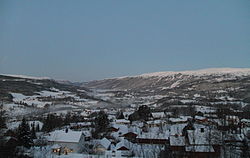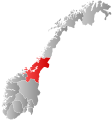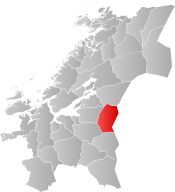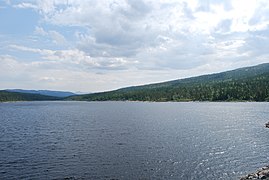Meråker
Meråker kommune | |
|---|---|
 View of the Meråker valley | |
 Trøndelag within Norway | |
 Meråker within Trøndelag | |
| Coordinates: 63°26′17″N 11°50′58″E / 63.43806°N 11.84944°ECoordinates: 63°26′17″N 11°50′58″E / 63.43806°N 11.84944°E | |
| Country | Norway |
| County | Trøndelag |
| District | Stjørdalen |
| Established | 1 Jan 1874 |
| Administrative centre | Midtbygda |
| Government | |
| • Mayor (2019) | Kjersti Kjenes (LL) |
| Area | |
| • Total | 1,273.94 km2 (491.87 sq mi) |
| • Land | 1,188.06 km2 (458.71 sq mi) |
| • Water | 85.88 km2 (33.16 sq mi) 6.7% |
| Area rank | 80 in Norway |
| Population (2020) | |
| • Total | 2,422 |
| • Rank | 259 in Norway |
| • Density | 2/km2 (5/sq mi) |
| • Change (10 years) | −2% |
| Demonym(s) | Meråkerbygg[1] |
| Time zone | UTC+01:00 (CET) |
| • Summer (DST) | UTC+02:00 (CEST) |
| ISO 3166 code | NO-5034 |
| Official language form | Bokmål[2] |
| Website | meraker |
Meråker is a municipality in Trøndelag county, Norway. It is part of the Stjørdalen region. The administrative centre of the municipality is the village of Midtbygda which is about 20 kilometres (12 mi) west of Storlien in Sweden and 46 kilometres (29 mi) east of the town of Stjørdalshalsen in neighboring Stjørdal municipality. Other villages in Meråker include Gudåa, Kopperå, and Stordalen.
The municipality markets itself as a recreational area. The main areas of employment are in industry and agriculture. The municipality is noted for its characteristic dialect.
The 1,274-square-kilometre (492 sq mi) municipality is the 80th largest by area out of the 356 municipalities in Norway. Meråker is the 259th most populous municipality in Norway with a population of 2,422. The municipality's population density is 2 inhabitants per square kilometre (5.2/sq mi) and its population has decreased by 2% over the previous 10-year period.[3][4]
General information[]
The municipality of Meråker was established on 1 January 1874 when the old municipality of Øvre Stjørdal was divided into two: Hegra (population: 3,409) in the east and Meråker (population: 1,861) in the west. The municipal borders have not changed since then.[5] On 1 January 2018, the municipality switched from the old Nord-Trøndelag county to the new Trøndelag county.
Name[]
The municipality (originally the parish) is named after the old Meråker farm (spelled "Mørakre" around 1430), since the first Meråker Church was built there. The meaning of the first element is uncertain (maybe merr which means "mare" or mýrr which means "bog" or "marsh") and the last element is akr which means "field" or "acre".[6]
Coat of arms[]
The coat of arms was granted on 28 September 1990. Traditionally, mining has played a major role in the area and has been of great economic importance for Meråker. Thus a silver mining cart on a red background as a symbol for the municipality was an obvious decision. The cart depicted in the arms, however, is officially described as a cart, not a mining cart.[7]
Churches[]
The Church of Norway has one parish (sokn) within the municipality of Meråker. It is part of the Stjørdal prosti (deanery) in the Diocese of Nidaros.
| Parish (sokn) | Church Name | Location of the Church | Year Built |
|---|---|---|---|
| Meråker | Meråker Church | Midtbygda | 1874 |
| Kopperå Chapel | Kopperå | 1936 | |
| Stordalen Chapel | Stordalen | 1863 |
History[]
Meråker Smelter[]
In 1898, a carbide factory was opened at Kopperå, later this factor was rebuilt as a silicon smelter. The smelter was in operation until June 2006. Its main product was microsilica which is used as an additive to cement.
Geography[]
Meråker is a landlocked municipality in the central part of Trøndelag county. To the north is the municipality of Verdal, to the west is Stjørdal, to the south is Selbu and Tydal, and to the east is Sweden.
There are three major lakes in Meråker: Feren, Fjergen, and Funnsjøen. The river Stjørdalselva runs through the municipality towards the Trondheimsfjord. The river Rotla begins in the southern part of Meråker. The mountain Fongen sits on the southern border with Tydal and Selbu.
Government[]
All municipalities in Norway, including Meråker, are responsible for primary education (through 10th grade), outpatient health services, senior citizen services, unemployment and other social services, zoning, economic development, and municipal roads. The municipality is governed by a municipal council of elected representatives, which in turn elect a mayor.[8] The municipality falls under the Inntrøndelag District Court and the Frostating Court of Appeal.
Municipal council[]
The municipal council (Kommunestyre) of Meråker is made up of 21 representatives that are elected to four year terms. The party breakdown of the council is as follows:
| Party Name (in Norwegian) | Number of representatives | |
|---|---|---|
| Labour Party (Arbeiderpartiet) | 5 | |
| Progress Party (Fremskrittspartiet) | 1 | |
| Centre Party (Senterpartiet) | 7 | |
| Socialist Left Party (Sosialistisk Venstreparti) | 2 | |
| Liberal Party (Venstre) | 1 | |
| Meråker Cross-Party Local List (Meråker Tverrpolitiske Bygdeliste) | 5 | |
| Total number of members: | 21 | |
Mayor[]
The mayors of Meråker (incomplete list):
- 2019–present: Kjersti Kjenes (LL)
- 2015-2019: Kari Anita Furunes (Sp)
- 1995-2015: Bård Langsåvold (Ap)
- 1973-1995: Svein Brækken (Ap)
Transportation[]
The European route E14 highway runs east to west through the municipality connecting to Trondheim Airport, Værnes about 40 kilometres (25 mi) to the west. The Meråker Line railway follows the E14 through the municipality also, with stops at Kopperå Station, Meråker Station, and Gudå Station.
Media[]
The newspaper Meråkerposten has been published in Meråker since 1982.[27]
Notable residents[]

- Anton Johnson Fridrichsen (1888 in Meråker – 1953) a Swedish theologian
- Helge Ingstad (1899 in Meråker - 2001) author, explorer and archeologist
- Arne Braa Saatvedt (1922 in Meråker – 1945) a Norwegian police official and member of the Nasjonal Samling, executed in 1945
- Bård Langsåvold (born 1952) a Norwegian politician, Mayor of Meråker 1995-2015
- Dag Lyseid (1954–2012) a footballer and politician, deputy Mayor of Meråker 1999-2008
- Vebjørn Selbekk (born 1969) a newspaper editor and author, brought up in Meråker
Sport[]
- Magnar Lundemo (1938 in Meråker - 1987) a cross country skier and track and field athlete, competed at the 1960 and 1964 Winter Olympics
- Frode Estil (born 1972) a retired cross country skier, lives in Meråker
- Kine Beate Bjørnås (born 1980) a retired cross country skier
- Simen Raaen Sandmæl (born 1990 in Meråker) a Norwegian footballer with over 130 club caps
Gallery[]

Meråker, Norway

Meråker smelteverk Kopperå

Elven Kopperåa i Kopperå, Meråker

Grønbergdammen in Meråker
References[]
- ^ "Navn på steder og personer: Innbyggjarnamn" (in Norwegian). Språkrådet.
- ^ "Forskrift om målvedtak i kommunar og fylkeskommunar" (in Norwegian). Lovdata.no.
- ^ Statistisk sentralbyrå (2020). "Table: 06913: Population 1 January and population changes during the calendar year (M)" (in Norwegian).
- ^ Statistisk sentralbyrå (2020). "09280: Area of land and fresh water (km²) (M)" (in Norwegian).
- ^ Jukvam, Dag (1999). "Historisk oversikt over endringer i kommune- og fylkesinndelingen" (PDF) (in Norwegian). Statistisk sentralbyrå.
- ^ Rygh, Oluf (1903). Norske gaardnavne: Nordre Trondhjems amt (dokpro.uio.no) (in Norwegian) (15 ed.). Kristiania, Norge: W. C. Fabritius & sønners bogtrikkeri. p. 2.
- ^ Norske Kommunevåpen (1990). "Nye kommunevåbener i Norden". Retrieved 8 November 2008.
- ^ Hansen, Tore, ed. (2016-05-12). "kommunestyre". Store norske leksikon (in Norwegian). Kunnskapsforlaget. Retrieved 2019-01-01.
- ^ "Tall for Norge: Kommunestyrevalg 2019 - Trøndelag". Valg Direktoratet. Retrieved 2019-10-20.
- ^ Jump up to: a b c d "Table: 04813: Members of the local councils, by party/electoral list at the Municipal Council election (M)" (in Norwegian). Statistics Norway.
- ^ "Tall for Norge: Kommunestyrevalg 2011 - Nord-Trøndelag". Valg Direktoratet. Retrieved 2019-10-20.
- ^ "Kommunestyrevalget 1995" (PDF) (in Norwegian). Oslo-Kongsvinger: Statistisk sentralbyrå. 1996. Retrieved 2020-04-12.
- ^ "Kommunestyrevalget 1991" (PDF) (in Norwegian). Oslo-Kongsvinger: Statistisk sentralbyrå. 1993. Retrieved 2020-04-12.
- ^ "Kommunestyrevalget 1987" (PDF) (in Norwegian). Oslo-Kongsvinger: Statistisk sentralbyrå. 1988. Retrieved 2020-04-12.
- ^ "Kommunestyrevalget 1983" (PDF) (in Norwegian). Oslo-Kongsvinger: Statistisk sentralbyrå. 1984. Retrieved 2020-04-12.
- ^ "Kommunestyrevalget 1979" (PDF) (in Norwegian). Oslo: Statistisk sentralbyrå. 1979. Retrieved 2020-04-12.
- ^ "Kommunevalgene 1975" (PDF) (in Norwegian). Oslo: Statistisk sentralbyrå. 1977. Retrieved 2020-04-12.
- ^ "Kommunevalgene 1972" (PDF) (in Norwegian). Oslo: Statistisk sentralbyrå. 1973. Retrieved 2020-04-12.
- ^ "Kommunevalgene 1967" (PDF) (in Norwegian). Oslo: Statistisk sentralbyrå. 1967. Retrieved 2020-04-12.
- ^ "Kommunevalgene 1963" (PDF) (in Norwegian). Oslo: Statistisk sentralbyrå. 1964. Retrieved 2020-04-12.
- ^ "Kommunevalgene og Ordførervalgene 1959" (PDF) (in Norwegian). Oslo: Statistisk sentralbyrå. 1960. Retrieved 2020-04-12.
- ^ "Kommunevalgene og Ordførervalgene 1955" (PDF) (in Norwegian). Oslo: Statistisk sentralbyrå. 1957. Retrieved 2020-04-12.
- ^ "Kommunevalgene og Ordførervalgene 1951" (PDF) (in Norwegian). Oslo: Statistisk sentralbyrå. 1952. Retrieved 2020-04-12.
- ^ "Kommunevalgene og Ordførervalgene 1947" (PDF) (in Norwegian). Oslo: Statistisk sentralbyrå. 1948. Retrieved 2020-04-12.
- ^ "Kommunevalgene og Ordførervalgene 1945" (PDF) (in Norwegian). Oslo: Statistisk sentralbyrå. 1947. Retrieved 2020-04-12.
- ^ "Kommunevalgene og Ordførervalgene 1937" (PDF) (in Norwegian). Oslo: Statistisk sentralbyrå. 1938. Retrieved 2020-04-12.
- ^ Smith-Meyer, Trond, ed. (2016-12-01). "Meråkerposten". Store norske leksikon (in Norwegian). Kunnskapsforlaget. Retrieved 2018-03-24.
External links[]
| Wikimedia Commons has media related to Meråker. |
- Meråker
- Municipalities of Trøndelag
- 1874 establishments in Norway







